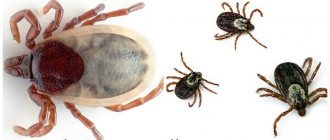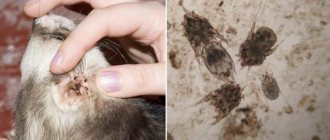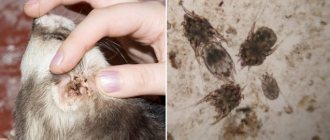A tick is a dangerous insect. Its habitat is varied: it is found in forests, parks, plantings, and even near private houses or high-rise buildings. Ticks live on bushes and grass, so they can very rarely be found at a height of more than one meter. The most active phase of tick life occurs in the autumn-spring period. These parasites can cause harm not only to humans, but also to animals, so it will be especially useful for pet owners to learn how to remove a tick from a cat.
Why you need to remove ticks
There is no need to remove a tick from a cat. Firstly, it will fall off on its own when it is full. Secondly, the cat can pull it off itself when it itches. In both cases, there is a high risk of contracting dangerous diseases. When bitten, the tick releases saliva, which contains anesthetic substances. Because of them, the cat does not feel the bite. This saliva also contains microorganisms that cause dangerous diseases: piroplasmosis, tick-borne encephalitis, hemobartonellosis, tularemia, etc. The longer the tick is on the cat’s body, the more saliva with pathogens it manages to release, the greater the risk of infection.
In addition, if you pull out a tick alive, it can and should be immediately sent to the laboratory for testing. If it turns out that he was a carrier of diseases, you can immediately begin treatment for your pet.
If you do not remove a tick from a cat, the animal will most likely brush it off when scratching, tearing the body of the parasite. In this case, the head with the proboscis may remain under the skin. This will increase the risk of infection, and a lump with redness will appear at the site of the bite - this means that infection has begun. Since such a place cannot be detected immediately, an abscess will begin, which will have to be opened by a veterinarian.
Features of the structure of ticks
There are about 850 species of ticks in nature, they are divided into two families: Ixodidae and Argasidae. Ixodid ticks have a hard shell and are more often found on animals than soft argasid ticks. Ticks are part of the arachnid class, so they look like spiders. They have a small head, four pairs of limbs and an oval body.
Once you find an insect, take a magnifying glass to determine the degree of suction:
- The paws are visible above the skin, and the body of the tick is black and round – the initial stage.
- The tick is black, resembles a drop, the legs are completely immersed in the skin of the animal, but the head is visible - the parasite is attached.
- The tick looks like a convex mole, and the head and paws are not visible - this means that the tick has already drunk blood, having been on the cat for about eight hours. A well-fed tick does not hold on so tightly.
How to detect ticks on a cat
If your pet goes for walks outside, you need to carefully examine it after each walk. They can be found anywhere on a cat’s body: on the neck, stomach, groin, on the inside of the paws, on the ears – outside and inside.
Short-haired cats just need to be examined, long-haired cats need to be felt by parting the fur. In order not to miss even a small tick, you need to inspect it in good lighting. When ticks drink blood, they noticeably increase in size, so it is simply impossible not to see them.
Examination of the animal
If the animal often goes outside, then after returning to the house it is necessary to conduct a thorough examination in order to detect the parasite in time. For someone who has never encountered ticks before, it is useful to know what they look like. On the body of the animal, the attached insect will appear as a flat brown drop. The size can vary significantly, depending on how much blood the tick has already drunk; it can even reach one and a half centimeters and resemble a large wart. If you look closely, you can see thin legs and a small head.
It is advisable to detect the parasite as early as possible, because it does not immediately bite the animal. A tick can crawl over a cat’s body for a long time in search of the most convenient place to bite (up to 2 hours). Therefore, if you examine the animal immediately after coming home, you can avoid unpleasant consequences.
There are places on a cat's body where ticks bite most often - these are the armpits, stomach, thighs, and behind the ears. Cats suffer from bites in the groin area.
When biting, the tick first makes a small incision on the skin, and then inserts its proboscis into it and tries to push it deeper. The insect's mouthparts are equipped with teeth and hooks, with the help of which it is attached to the body very securely in order to begin sucking blood and lymph from the animal.
While feeding, the parasite gives its victim a kind of anesthetic injection so that it does not feel pain from the bite, and therefore cannot throw off the insect. Therefore, you should carefully examine the animal, probe the most dangerous areas and thoroughly comb the fur in different directions.
How to remove ticks from a cat at home
If your cat is very worried about a tick bite, and if you can’t restrain it and calm it down, it’s better to go to the clinic. You need to act carefully, confidently and quickly. The problem with cats is that you can't get them to sit or lie still. It can be very difficult to cope alone. It is good to work together, so that one person holds the animal, and the second takes out the tick that has drunk blood.
Removing a tick is possible using improvised means. You need to prepare for the procedure:
- prepare a tool for removing ticks, scissors for cutting hair around the wound, a magnifying glass;
- prepare a container with a wet cotton pad and a lid in order to submit the tick to the laboratory;
- antiseptic for treating wounds (Medilis-ASEPT is suitable for these purposes. Skin antiseptic "Medilis-ASEPT" has been produced since 2015 and is officially registered as a medical disinfection product by Rospotrebnadzor and is a professional product, not a cosmetic product);
- Wash the hands. wear gloves, and if possible, protect your eyes with goggles, since if removal is unsuccessful, blood may spray out from the crushed parasite.
The cat must be calmed and, if necessary, swaddled if this does not interfere with removing the tick. It is advisable to trim the hair around the bite site so that it does not interfere with removal.
There is no need to give your cat any sedatives or pills.
What to do with a removed tick
Throwing out a parasite is reckless, and squeezing is useless. Collected ticks are burned along with a piece of cloth, napkin or cloth, if they were purposefully collected on the territory. When an insect is removed from human skin, it is recommended that the individual be sent to a laboratory. This will make it possible to accurately determine whether she is a carrier of a dangerous disease and which one. Information is necessary for further monitoring of well-being and tracking the most striking symptoms during the period of possible incubation, since treatment is effective precisely at the first manifestations of the disease.
For preventive purposes, immunoglobulin or doxycycline is prescribed. The doctor makes the appointment, he also writes the prescription and observes the patient. If the study shows that the tick is not a carrier of any pathogen, then emergency chemoprophylaxis is not carried out.
Before the spring season, it is worth purchasing a device in advance for the safe removal of ticks and meeting a possible aggressor in full combat readiness.
How to remove a tick from a cat: step-by-step instructions
To remove a tick, you do not need to pull it out of the cat's body. The main rule to follow is: pick up an insect, turn it and pull it out with a twisting motion.
There are several ways to remove ticks at home:
- With a thread. They make a lasso-type loop out of it, throw it over the pest, tighten it, but not too much, and then pull it out, unwinding it from side to side or twisting it counterclockwise.
- With tweezers. They grab the tick as close to the cat's skin as possible, while it is better to hold the tweezers parallel to the skin, without squeezing the body too tightly so as not to tear it.
- With a syringe. The head of a small syringe is cut off and placed against the skin so that the tick is inside. Pull out the piston, creating a vacuum. The tick should be pulled out of the skin under pressure. This method is quite dubious, since the pressure may not be enough to pull out the insect, and it will go even deeper under the skin.
- A twister. This is a special device that is sold in pharmacies. It looks like a small nail puller, which is used to pick up the parasite and twist it out of the pet’s body. The device is made taking into account the anatomical features of the tick, so there is no risk of crushing or tearing it.
When removing ticks using any of the above methods, the most important thing is not to tear the parasite. It is quite easy to crush and separate the head from the body. If the head of the tick remains under the cat's skin, it should be removed.
The most convenient tool is a twister. They come in two sizes - for small ticks that have not yet had time to increase in size, and for large ones that have sucked blood. The tick is fixed between the teeth of the twister, so it won’t go anywhere. However, it cannot be crushed. It is turned with a handle around its axis, so that it unclenches its jaws and comes out of the wound entirely.
How to remove a tick if it has not yet attached itself
When removing a tick, be sure to wear gloves; you can also put a plastic bag on your hand. The tick cannot be crushed; it must be placed in a bottle. Touching a bloodsucker in itself is not dangerous, but there is no guarantee that when caught, the tick will not be crushed, and the causative agents of dangerous infections will not end up on the human skin and mucous membranes.
Any tick that has not attached itself must be burned . You should not throw it in the trash or down the drain - this will not destroy it.
How to tell if a tick has bitten your pet
If the tick moved freely, there is a high probability that it chose a place to bite and did not have time to penetrate the skin. Signs of a tick bite do not have typical differences - the site of penetration will look like a small tubercle of swelling or inflammation with a small pinpoint wound from which bloody fluid may ooze, since the tick's saliva contains substances that prevent blood clotting. The cat may scratch the bite site.
A tick can dig in absolutely anywhere, but more often it is found in secluded places where the skin is thin, the capillaries are close and where it will be difficult to scratch it off with a paw. Therefore, bloodsuckers are most often found:
- in the armpit and groin areas;
- on the stomach;
- behind the ears;
- at the withers;
- on the front of the neck;
- in the area under the tail.
If the tick has burrowed in for a long time, then its head and front legs may already be in the thickness of the skin. The head of this arachnid is fixed very firmly. To the touch, a sucked tick is a soft elastic tubercle located where it was not there before.
You should be careful not to mistake your cat’s nipples for ticks; Cats also have rudimentary (weakly expressed) nipples.
What not to do
After tick bites, you should never remove them in the following ways:
- cauterize;
- fill with oil;
- pour with gasoline, turpentine, vinegar, and other liquids.
It is believed that when poured with oil, the tick will begin to suffocate and crawl out on its own. But that's not true. It can go even further under the skin. Cauterization can injure your pet. When poured with caustic liquids, the tick will die, but during its agony it will squirt even more infected saliva into the wound. In addition, these fluids will get into the wound and cause suffering to the cat.
You should also not simply pull the tick out with your fingers. Firstly, it is so easy to crush it. Secondly, when crushed or torn, drops of infected blood can fall on a person. And if there are microtraumas on the fingers, then you can get infected. When you pull, you will likely tear the insect apart, leaving the head underneath the skin.
Where to look for ticks on the body
For an ectoparasite, saturation with blood is a necessary condition for the further development of the body; the entire system is subordinated to the function of biting and holding on to the body of the victim. Among the adaptation mechanisms, the main one is the search for a power source. Ticks can smell skin, sweat, and body heat from several tens of meters away. At the same time, the parasite very carefully selects hunting sites, prey and the place of attachment to it, preferring the neck, elbow bends, armpits and scalp. It is there that the skin is more delicate, and the chances of detecting and destroying the pest are several times less.
What to do after deletion
After removing the tick from the cat's body, it is necessary to treat the wound. A variety of antiseptics are suitable for this. You can take what you have on hand: brilliant green, iodine, chlorhexidine, alcohol, hydrogen peroxide. Please note that iodine is not applied directly to the wound, but is treated around the bite site.
If after removal the tick remains alive, it is placed in a container and taken to the laboratory for analysis. This must be done within two days after removal.
If you do not want or cannot send it for research, then the parasite must be destroyed, but this must be done carefully so that its particles do not fall on anyone.
The cat should be monitored for approximately two weeks after the bite. During this time, symptoms of the disease may appear. If an animal refuses to eat, becomes lethargic or restless, strange movements appear, or orientation is disturbed, this is a reason to contact a veterinarian. Symptoms of infection also include fever and vomiting.
Bite site
Detecting a tick is not so easy. If a person has a rash and redness on the skin, then in an animal this is not visible behind the fur. Therefore, after every walk, inspect your cat for ticks. This is especially true for those who live close to fields or forests - the main habitats of parasites. But even if you live in an urban area, you shouldn’t relax. There is a chance of catching a parasite in urban areas.
Today, the species diversity of ticks reaches 50 thousand. Not all of them are dangerous. Some people generally believe that they only bring harm to humans. But in fact, the bite of an infected tick is fatal in animals. Even if a tick is not a carrier of diseases, it will cause a lot of inconvenience to the animal.
The cat will try to pull it out, which will lead to irritation and the tick will burrow even deeper. Therefore, you need to immediately get it when found.
One of the most common misconceptions is that you need to lubricate the tick with oil. There are also options with wax or kerosene. So: it is strictly forbidden to treat the bite site! This way you deprive the parasite of access to oxygen. Yes, it will fall off, but while this happens, the tick will secrete even more toxic saliva from stress, which will lead to more poison entering the cat’s body. And if he is a carrier, then the clock counts. Therefore, you can treat the bite site only after the tick has been completely removed.
When removing yourself, do not crush the tick. This way the poison will still reach its target. Don’t try to pick it apart with something sharp or take it out piece by piece. All this will cause great harm to your animal.
Prevention
Unfortunately, there is no effective prevention to protect cats from ticks. They are not vaccinated. Treating them with repellents before each walk is ineffective; besides, the cat will lick off any products applied to the fur, and this is dangerous.
You can wear a special collar that protects against ticks and other parasites, or acaricidal drops on the withers.
If a cat has limited time walking in a garden plot near a dacha or private house, it is advisable to treat it against ticks. For this you can use, for example, Medilis-Ziper concentrate. A working solution is prepared from it, which is poured into spraying equipment and the surface is treated with grass, shrubs up to 50 cm in height. It is necessary to strictly follow the instructions when preparing the solution and treating the area, and be sure to use personal protective equipment. One treatment is enough for 1 – 1.5 months. All this will protect not only your beloved cat, but also people from tick attacks. Insects will not come to the treated area.
Signs of a bite and why it is dangerous
Blood-sucking insects of the parasitic type are very leisurely; they know that as soon as contact is found with the carrier, the percentage that they will not be able to bite is negligible. Protective coloring and small size make the pest almost invisible on dark and colorful clothing. From the moment of preparation to direct attachment to the skin, it can take about 20 minutes.
At the stage of blood sucking, anticoagulants enter the host tissue, preventing the process of blood clotting and the parasite can feed for a long time. They act like a pain reliever and the person does not feel discomfort. Removing a tick at the initial stage, before the bite, is possible with care and a certain amount of luck. Even while the ectoparasite is feeding, it can only be noticed visually upon careful examination.
Only when digestive enzymes of saliva are injected into the wound and partial dissolution of the surrounding tissue begins, local inflammation develops, itching, a burning sensation appears, and the temperature may rise. Externally, this is expressed in redness, swelling, and compaction, which can be easily felt with your fingers.
The danger lies not in the bite itself, but in the saliva of the pest, along with which the pathogens of Lyme disease and tick-borne encephalitis can penetrate. They are severe and can lead to disability. The most dangerous are ixodid forest ticks and the meadow variety.
Diseases of cats caused by subcutaneous mites
Notoedrosis (pruritic scabies) – Notoedrosis is a chronic invasive disease of cats, clinically accompanied by dermatitis in the scalp, itching, scratching and hair loss.
Etiology. The causative agent of Notoedrosis in cats is the sarcoptic mite Notoedrosis cati. Its morphology is somewhat similar to mites of the genus Sarcoptes. The body of sexually mature ticks is round in shape and dirty gray in color. It has a body length of 0.14-0.45 mm. The proboscis is horseshoe-shaped, the anus is located on the dorsal side, and in females there is also a copulatory opening. The legs of the tick are short, thick, and cone-shaped. Male ticks have bell-shaped suckers on conical rods (ambulacras) on the 4th pair of legs. In females, the 3rd and 4th pair of legs do not have bell-shaped suckers. Itches parasitize and multiply in passages that they gnaw in the deep parts of the stratum corneum of the skin, directly bordering the malpighian layer.
Developmental biology, epizootological data, pathogenesis, clinical picture, diagnosis, differential diagnosis, treatment and prevention are described in our article - Notoedrosis (pruritic scabies) in cats.
Feline demodicosis is a chronic parasitic skin disease in cats caused by the microscopic worm-like mite Demodex cati.
Etiology. The causative agent of demodicosis, being itself an endoparasite, is localized in the hair follicles and sebaceous glands. It is half a millimeter long and has a transparent body with poorly defined boundaries between the cephalothorax and abdomen. It has short legs with hooks at the ends. The oral apparatus is equipped with a gnawing type proboscis. When a cat is infected with demodicosis, the parasite first penetrates the skin. At the site where the tick gnaws through the skin, it leaves a pronounced concentric spot. Having penetrated the skin, mites begin to feed on skin cells, and the mites multiply intensively. For more information about demodicosis in cats, see our article – Demodicosis in cats.
Otodectosis or ear scabies is a chronic invasive disease of cats caused by parasitic otodectosis mites on the inner surface of the ears and in the external auditory canal.
For more information about the disease, see our article – Otodectosis in cats.
What is the danger
Are ticks dangerous for cats or do they only bite dogs?
Many people doubt whether ticks bite cats and believe that this type of parasite does not affect them. It is a myth. Representatives of Ixodidae bite everyone. It’s just that dogs constantly visit the street and parasitic diseases are recorded more often in them.
The Ixodid tick is a small spider with a disk-shaped body, a small head and 8 legs (see photo).
Color – all shades of brown. Females drink more blood. If the parasite is hungry, its body is approximately 2-4 mm in size. But the gluttony is surprising. The body weight of females increases 80-120 times during feeding. When she drinks blood, she is able to swell into a ball up to 1.5 cm, and the color changes from brown to dirty gray.
The danger for cats lies in the ability of ixodids to be carriers of various serious diseases. The culprits of diseases are protozoan parasites and viruses that live in the body of an ectoparasite.
The consequences of a bite are manifested by such infectious diseases as:
- hemabartonellosis;
- borreliosis;
- theileriosis;
- piroplasmosis;
- babesiosis
Any parasitic disease does not develop immediately after a bite. Time must pass - on average 2-3 days, sometimes more.
How difficult the disease will be depends on a number of factors:
- the general well-being of the animal and the state of immunity;
- age;
- number of bitten bloodsuckers;
- timeliness of measures taken by the owner.
Pregnant cats and kittens are especially at risk. If an infection or virus enters the body of a pregnant animal, then the offspring will also be affected.
How not to pull it out
Seeing a small spider on a pet, many owners panic and often make mistakes:
- They fulfill their first desire - to rip off the parasite
There should be no sudden movements or jerks. They pull it out with twisting movements in one direction so that the spines on the proboscis do not puff up, but press against it. This is the only way to remove the parasite along with the head.
- Lubricated with oil
Vaseline, vegetable oil, and machine oil are used to cut off oxygen to the parasite. The effect will be that the tick will not like this method, and it will begin to move backwards, perhaps even falling off the cat’s body. However, while this happens, he will have time to inject infected saliva. The moment has passed.
- They're putting pressure
By crushing a tick with your fingers, the cat owner increases the risk of infected blood getting into the wound.
How dangerous are ticks for a cat?
There are a large number of types of mites: ear mites, scabies mites, ixodid mites. Infection of any kind poses a potential danger to your pet's health and causes unpleasant symptoms. But the most serious consequences can await a cat when bitten by ixodid ticks.
Ixodid ticks are known carriers of infectious diseases. Their habitat is very extensive.
The maximum height to which the ixodid tick can rise is 70 cm. Therefore, contrary to popular belief, the largest concentration of these arachnids is observed not on trees, but in the grass and on the branches of low-growing bushes.
According to statistics, recently there has been activity of ixodid ticks from early spring to late autumn.
For a cat, a tick poses exactly the same danger as for a person. The most serious consequences will develop if the tick is a carrier of:
- encephalitis - an infection that affects the brain, which leads to paralysis and/or death of the animal (there is symptomatic treatment, but complete recovery of the pet is impossible);
The habitat of ixodid ticks, which are carriers of encephalitis, is quite extensive.
- piroplasmosis - an infection caused by protozoan microorganisms that parasitize blood cells and develops at lightning speed (only 2 days can pass from the onset of symptoms to the death of the animal);
- hemobartonellosis - an infection caused by protozoan microorganisms that infect blood cells - red blood cells, does not pose a mortal danger, but against the background of anemia and decreased immunity, bacterial infections may develop or chronic diseases may worsen.
In addition, there is a danger of infection of the tick bite site and the addition of a bacterial infection. The consequences, of course, will not be as sad as those caused by infection with the diseases listed above, but nevertheless it will bring enough suffering to the animal.











